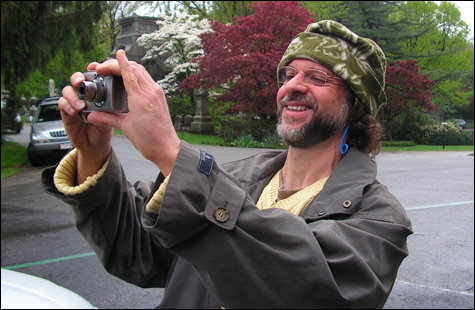
SHOT OF LOVE: Brandão reclaims bossa nova from the elevators. |
By now, the bossa nova of Antonio Carlos Jobim (1927–1994) has been completely ingrained in the language of jazz and pop — from Getz and Sinatra to Bebel Gilberto, lounge music, Nouvelle Vague, and Keren Ann. In its simplest form, it’s the sound of a melancholy, a solitary singer crooning long vibratoless tones over the clave-like rhythms of finger-picked nylon-string guitar.
The Rio de Janeiro–born, long-time-Boston-based guitarist and songwriter Sergio Brandão and his band Manga-Rosa delivered another kind of bossa at the Regattabar a week ago Saturday. This was bossa nova as food for great jazz: orchestral, rich with transparent harmonic textures, not simply a pop-song format but a resource for improvisation. Bossa nova (“new trend” or “new thing”) is “not a kind of composition, but the way the composition is played,” Brandão explained before the second set. Think of it, he said, as like the more percussive, folk-based samba, but “smoothed out.”
Smooth didn’t mean elevator music, however. Brandão and his rhythm mates created sinuous grooves, bassist Esperanza Spalding working in and around the 1 and 3, Brandão plucking syncopated chords, drummer Mark Wilson sustaining a fast, metronomic, singing chik-chik-boom on his drums and hi-hat. Brandão opened with an instrumental, his own “Samba em sete” (“Samba in 7”), and when vibist Alexei Tsiganov came in, it was with a full-on percussive attack, which he augmented with his body language — hunched at the waist, arms flying. Brandão, meanwhile, plays not the plugged-in acoustic you might expect with this music but a hollow-bodied electric Gibson. When he solo’d, he conjured the glycerin-toned swing of Wes Montgomery or, later, the electricity of Pat Metheny rather than the nylon-string serenades of João Gilberto.
Argentine singer Sofía Koutsovitis is an adept arranger in her own bands, and here she was effective as one voice among many — carrying the lead melody lines in a rich alto, harmonizing with Brandão’s supporting vocals, or blending with the horns. Brandão made the most of his three horns: Greg Hopkins alternated trumpet and flügelhorn, Daniel Ian Smith went from flute to soprano and tenor saxes, and Brandão’s brother, the great flutist Fernando Brandão, provided his usual steel-in-velvet sound. Sergio often deployed all three horns in twining harmonies and counterlines. Pianist Gilad Barkan was as impressive for what he didn’t do as for what he did: playing with restraint, soloing with attention to the purity of the legato line, like another singer.
The repertoire covered everything from what Brandão called “the very beginning of bossa nova” in 1958, with “Chega de saudade” (“No More Blues”) up through Jobim’s lesser-known later pieces concerned with ecology (“O boto” — “The Dolphin” — from the late ’60s). Late in the set there was the inevitable “Garota de Ipanema” (in a fresh, open arrangement with a free intro). A slide show of Brandão’s photos of Rio floated behind the band on a screen: city, surf, harbor, hills.